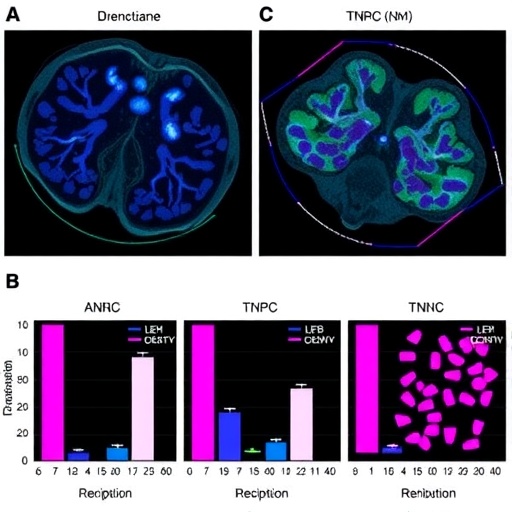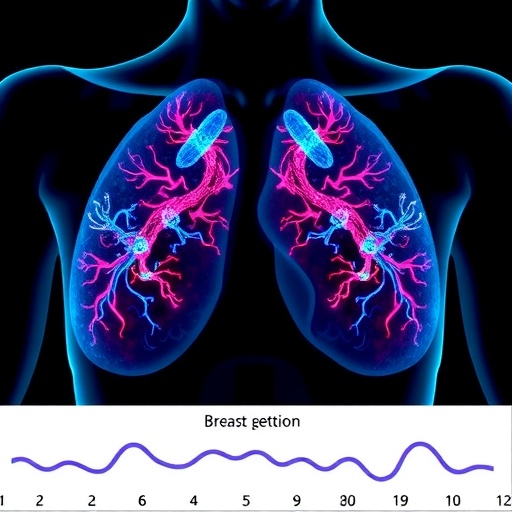Cancer immunotherapy has revolutionized the landscape of blood cancer treatment, especially through the deployment of bioengineered T cells. Among these, chimeric antigen receptor T cells, or CAR-T cells, have demonstrated remarkable success in eliminating malignant cells circulating in the bloodstream. However, this triumph has been notably constrained when addressing the more formidable challenge of solid tumors, such as those developing in breast, lung, or prostate tissues. Despite the extraordinary precision and potency these engineered T cells wield, their efficacy is frequently undermined by the complex and suppressive milieu in which solid tumors reside.
At the heart of this resistance lies the tumor microenvironment (TME)—a highly intricate and dynamic assembly of cellular and molecular components that collectively inhibit effective immune attack. This hostile environment is characterized by a predominance of inhibitory signals that effectively mute T cell activity, while the co-stimulatory cues necessary to sustain immune cell function are either markedly diminished or absent. Engineered T cells, including CAR-T therapies, rely heavily on these environmental signals to maintain their activation, proliferation, and cytotoxic functions. Without adequate stimulatory inputs, these cells become exhausted or anergic, thereby failing to eradicate tumor cells effectively. Overcoming this barrier entails designing innovative strategies to equip T cells with synthetic receptors capable of directly sensing and responding to these tumor-specific cues, effectively bypassing the suppressive signals.
In an ambitious stride toward conquering this hurdle, a research team led by Patrick Barth at EPFL and Caroline Arber at UNIL-CHUV has harnessed the power of computational protein engineering to create synthetic receptors from first principles. These proprietary receptor constructs, dubbed T-SenSERs (tumor microenvironment-sensing switch receptors), have been engineered to detect soluble molecular cues prevalent within the TME and translate these signals into co-stimulatory or cytokine-like outputs that potentiate T cell activation. By integrating these synthetic receptors with CAR-T cells, the hybrid immune cells exhibit enhanced anti-tumor efficacy, as demonstrated in preclinical models of lung cancer and multiple myeloma.
The research, recently published in Nature Biomedical Engineering, introduces an inventive computational platform designed to assemble synthetic receptor proteins modularly—akin to constructing intricate architectures with molecular Lego blocks. Each receptor is composed of distinct functional domains meticulously optimized for their roles: an extracellular ligand-binding domain that recognizes tumor-associated soluble factors, a transmembrane segment that efficiently conveys conformational signals across the lipid bilayer, and an intracellular effector domain that initiates desired signaling cascades within the T cell cytoplasm. This modular design framework permits unprecedented customization of receptor function and specificity.
A striking innovation of Barth and colleagues’ computational platform is its dynamic modeling of proteins as flexible, shape-shifting entities rather than static structures. This approach enables in silico visualization of signal propagation through receptor domains, providing critical insight into how engineered receptors can transduce external ligand engagement into precise intracellular responses. This conceptual leap departs from conventional rigid-body approximations, allowing for a more nuanced understanding and predictive control over receptor function, ultimately accelerating the design cycle and enhancing receptor efficacy before bench validation.
The researchers utilized this framework to engineer and refine two distinct classes of T-SenSERs. The first set targets vascular endothelial growth factor (VEGF), a soluble protein extensively secreted by tumors to stimulate angiogenesis, creating new blood vessel networks that facilitate tumor growth and metastasis. The second class detects colony-stimulating factor 1 (CSF1), a modulator known to reprogram immune cell behavior in the TME, often fostering immunosuppression. By generating 18 receptor variants through computational prediction and experimental screening, the team isolated candidates displaying optimal ligand sensitivity, basal activity, and signaling outputs.
Functional assays confirmed that T cells co-expressing both CARs and T-SenSERs manifested augmented tumor recognition and killing capabilities compared to CAR-T cells alone. The VEGF-responsive receptor variant—designated VMR—remained quiescent in the absence of VEGF but triggered robust intracellular activation upon ligand binding. Conversely, the CSF1-responsive receptor, termed CMR, exhibited a nuanced signaling profile with a modest basal activity that intensified in the presence of its ligand. These differential activation patterns illustrate the fine-tuned programmability achieved through computational design, enabling tailoring of receptor responsiveness to the unique biochemical landscape of individual tumors.
In vivo investigations in murine lung cancer and myeloma models provided compelling evidence of the therapeutic advantage conferred by T-SenSER-modified T cells. These engineered cells demonstrated superior tumor growth suppression and extended animal survival relative to controls. The ability to harness and amplify endogenous tumor-derived signals to orchestrate T cell function unveils a promising frontier for improving the clinical efficacy of CAR-T therapies against refractory solid tumors.
Beyond therapeutic outcomes, this study highlights the profound potential of computational design to customize receptor signaling modalities. Researchers can now dictate whether receptors function as strictly ligand-gated switches, constitutively active units, or intermediates featuring graded responses—all encoded at the protein design stage. This capability lays the foundation for next-generation synthetic biosensors capable of complex, context-dependent cellular programming within hostile microenvironments.
Barth emphasizes that these findings represent the inaugural demonstration of single-pass, multi-domain receptors engineered with programmable signal transduction activities via computational means. This pioneering platform not only accelerates the generation of synthetic receptors for cancer immunotherapy but also offers broad applicability for creating bespoke biosensors in cell engineering initiatives across diverse biomedical fields.
Collaborators contributing to this groundbreaking work include leading institutions such as the Ludwig Institute for Cancer Research, Baylor College of Medicine, Swiss Cancer Center Leman, and AGORA Cancer Research Center, underscoring the interdisciplinary and international nature of this endeavor.
This extraordinary advance signals a paradigm shift in cancer immunotherapy by enabling engineered T cells to autonomously sense the tumor milieu and modulate their activity dynamically. As synthetic biology converges with computational modeling, the dream of universally effective solid tumor immunotherapies draws closer to reality, promising new hope for patients battling some of the most intractable cancers.
Subject of Research: Computational design of synthetic protein receptors to enhance cancer T cell therapy by sensing tumor microenvironment signals.
Article Title: Computational design of synthetic receptors with programmable signalling activity for enhanced cancer T cell therapy.
News Publication Date: 28 October 2025
Web References: https://www.nature.com/articles/s41551-025-01532-3
References: Jan A. Rath, Lucas S. P. Rudden, Nazila Nouraee, Tiffany X. Y. Que, Christine Von Gunten, Cynthia Perez, Flora Birch, Yashashvi Bhugowon, Andreas Fueglistaler, Aisima Chatzi Souleiman, Patrick Barth, Caroline Arber. Nature Biomedical Engineering, 28 October 2025. DOI: 10.1038/s41551-025-01532-3
Keywords: Cancer immunotherapy, CAR-T cells, synthetic receptors, tumor microenvironment, computational protein design, T-SenSER, VEGF, CSF1, synthetic biology, protein engineering, solid tumors, programmable signaling.
Tags: bioengineering for cancer therapycancer immunotherapy advancementsCAR-T Cell Therapychimeric antigen receptors in cancerengineered T-cellsenhancing T cell cytotoxicityimmune cell activation mechanismsinnovative cancer treatment approachesovercoming inhibitory signals in tumorssolid tumor treatment strategiesT cell exhaustion in cancertumor microenvironment challenges





